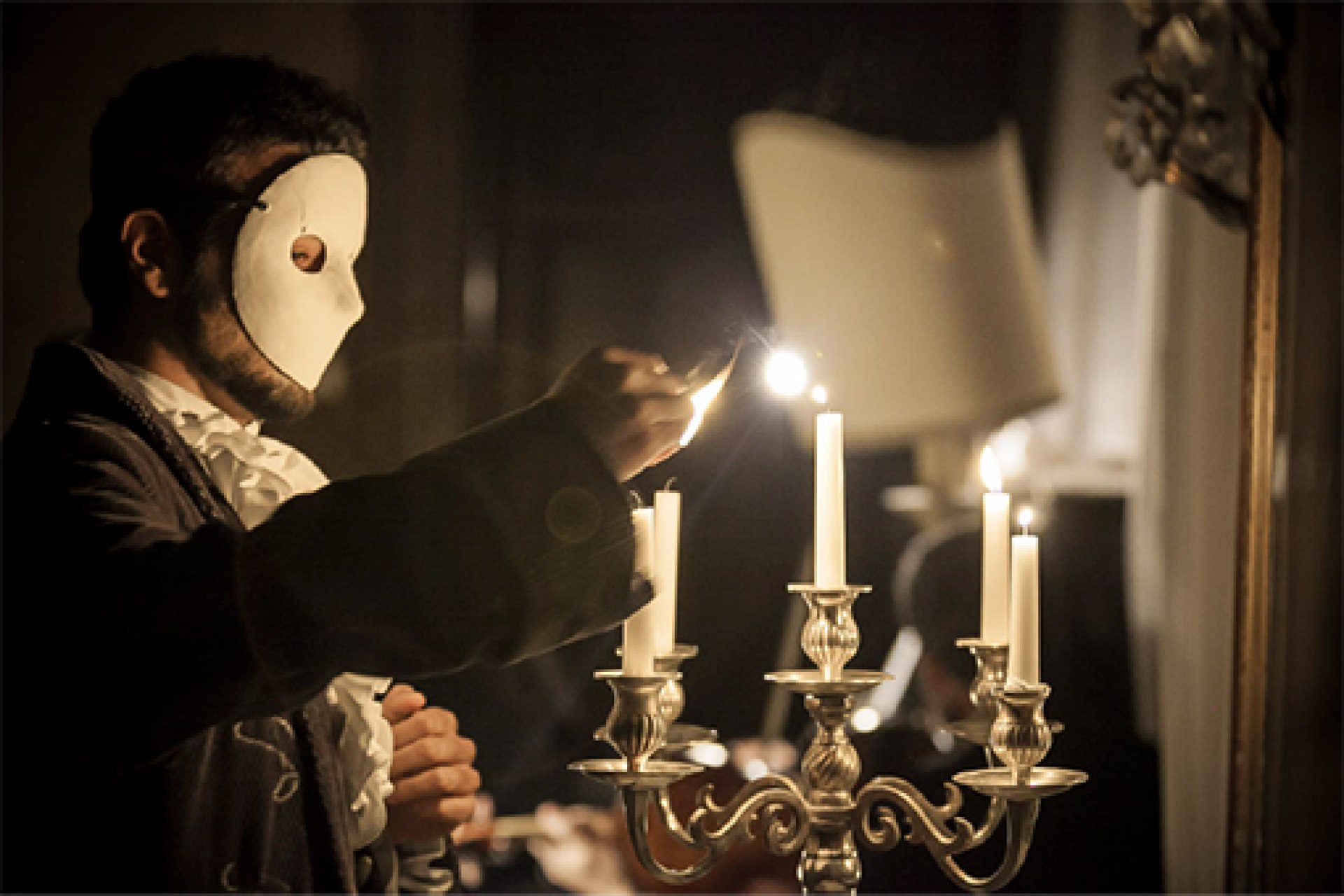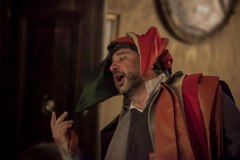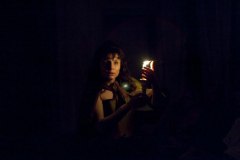Rigoletto
Mo | Tu | We | Th | Fr | Sa | Su |
Rigoletto is an opera in three acts by Giuseppe Verdi; its libretto is by Francesco Maria Piave. It had a triumphant premiere at the La Fenice Theatre in Venice, on March 11th 1851.
Rigoletto is an intense drama about passion, treachery, filial love and vengeance. The tragedy of Rigoletto revolves around the “curse” , which causes the inexorable and tragic fall of the main character: “The whole subject is in that curse, which will also prove to be moral” (G. Verdi).
The first act of the opera begins in the Tiepolo Hall, where Anthony Knight’s wonderful costumes, inspired by the 18th century style, blend perfectly into the magnificent Baroque Palace furnishings.
Rigoletto travels and unfolds throughout the halls of the Palace where the choice to use candlelight creates a Caravaggio-style backlighting which enhances the dramatic power of the Opera.
Synopsis
Place: Mantua
Time: the sixteenth century
Act 1
Scene 1: Mantua. A magnificent hall in the ducal palace. Doors at the back open into other rooms, splendidly lit up. A crowd of lords and ladies in grand costumes are seen walking about in the rear rooms; page boys come and go. The festivities are at their height. Music is heard from offstage. The Duke and Borsa enter from a door in the back.
At a ball in his palace, the Duke sings of a life of pleasure with as many women as possible, and mentions that he particularly enjoys cuckolding his courtiers: "Questa o quella" ("This woman or that"). He mentions to Borsa that he has seen an unknown beauty in church and desires to possess her, but he also wishes to seduce the Countess of Ceprano. Rigoletto, the Duke's hunchbacked court jester, mocks the husbands of the ladies to whom the Duke is paying attention, including the Count Ceprano. He humorously advises the Duke to get rid of Count Ceprano by prison, exile, or death. The Duke laughs indulgently, but Ceprano is not amused. Marullo, one of the guests at the ball, informs the courtiers that Rigoletto has a "lover", which astonishes them. (Marullo is not aware that the "lover" is actually Rigoletto's daughter.) The courtiers, at Ceprano's suggestion, resolve to take vengeance on Rigoletto for making fun of them. The festivities are interrupted by the arrival of the elderly Count Monterone, whose daughter the Duke had seduced. Rigoletto provokes him further by making fun of his helplessness to avenge his daughter's honor. Monterone confronts the Duke, and is immediately arrested by the Duke's guards. Before being led off to prison, Monterone curses both the Duke for the attack on his daughter and Rigoletto for having mocked his righteous anger. The curse terrifies Rigoletto, who believes the popular superstition that an old man's curse has real power.
Scene 2: The end of a dead-end street. On the left, a house of discreet appearance with one small courtyard surrounded by walls. In the yard there is one tall tree and a marble seat; in the wall, a door that leads to the street; above the wall, a terrace supported by arches. The second floor door opens on to the said terrace, which can also be reached by a staircase in front. To the right of the street is the very high wall of the garden and a side of the Ceprano palace. It is night.
Preoccupied with the old man's curse, Rigoletto approaches the house where he is concealing his daughter from the world and is accosted by the assassin Sparafucile, who walks up to him and offers his services. Rigoletto declines for the moment, but leaves open the possibility of hiring Sparafucile later, should the need arise. Sparafucile wanders off, after repeating his own name a few times. Rigoletto contemplates the similarities between the two of them: "Pari siamo!" ("We are alike!"); Sparafucile kills men with his sword, and Rigoletto uses "a tongue of malice" to stab his victims. Rigoletto opens a door in the wall and embraces his daughter Gilda. They greet each other warmly: "Figlia!" "Mio padre!" ("Daughter!" "My father!"). Rigoletto has been concealing his daughter from the Duke and the rest of the city, and she does not know her father's occupation. Since he has forbidden her to appear in public, she has been nowhere except to church and does not even know her own father's name.
When Rigoletto has gone, the Duke appears and overhears Gilda confess to her nurse Giovanna that she feels guilty for not having told her father about a young man she had met at the church. She says that she fell in love with him, but that she would love him even more if he were a student and poor. As she declares her love, the Duke enters, overjoyed. Gilda, alarmed, calls for Giovanna, unaware that the Duke had given her money to go away. Pretending to be a student, the Duke convinces Gilda of his love: "È il sol dell'anima" ("Love is the sunshine of the soul"). When she asks for his name, he hesitantly calls himself Gualtier Maldè. Hearing sounds and fearing that her father has returned, Gilda sends the Duke away after they quickly trade vows of love: "Addio, addio" ("Farewell, farewell"). Alone, Gilda meditates on her love for the Duke, who she believes is a student: "Gualtier Maldè!... Caro nome che il mio cor" ("Dearest name").
Later, Rigoletto returns: "Riedo!... perché?" ("I've returned!... why?"), while the hostile courtiers outside the walled garden (believing Gilda to be the jester's mistress, unaware she is his daughter) get ready to abduct the helpless girl. They tell Rigoletto that they are actually abducting the Countess Ceprano. He sees that they are masked and asks for a mask for himself; while they are tying the mask onto his face, they also blindfold him. Blindfolded and deceived, he holds the ladder steady while they climb up to Gilda's room: Chorus: "Zitti, zitti" ("Softly, softly"). With her father's unknowing assistance Gilda is carried away by the courtiers. Left alone, Rigoletto removes his mask and blindfold, and realizes that it was in fact Gilda who was carried away. He collapses in despair, remembering the old man's curse.
Act 2
A room in the ducal palace. There are doors on both sides as well as a larger one at the far end by the sides of which hang full length portraits of the Duke and his wife. There is one high-backed chair at a table covered with velvet and other furnishings.
The Duke is concerned that Gilda has disappeared: "Ella mi fu rapita!" ("She was stolen from me!") and "Parmi veder le lagrime" ("I seem to see tears"). The courtiers then enter and inform him that they have captured Rigoletto's mistress: Chorus: "Scorrendo uniti" ("We went together at nightfall"). By their description, he recognizes it to be Gilda and rushes off to the room where she is held: "Possente amor mi chiama" ("Mighty love beckons me"). RigoA portion of Sparafucile's house is seen, with two rooms open to the view of the audience. Rigoletto and Gilda arrive outside. The Duke's voice can be heard from inside, singing "La donna è mobile" ("Woman is fickle"). Sparafucile's sister, Maddalena, has lured him to the house. Rigoletto and Gilda listen from outside as the Duke flirts with Maddalena. Gilda laments that the Duke is unfaithful; Rigoletto assures her that he is arranging revenge: "Bella figlia dell'amore" ("Beautiful daughter of love").
Rigoletto orders Gilda to put on a man's clothes to prepare to leave for Verona and tells her that he plans to follow later. After she leaves, he completes his bargain with the assassin, who is ready to murder his guest for 20 scudi. Rigoletto then withdraws.
With falling darkness, a thunderstorm approaches and the Duke decides to spend the rest of the night in the house. Sparafucile directs him to the upstairs sleeping quarters, resolving to kill him in his sleep.
Gilda, who still loves the Duke despite knowing him to be unfaithful, returns dressed as a man and stands outside the house. Maddalena, who is smitten with the Duke, begs Sparafucile to spare his life: "È amabile invero cotal giovinotto/ Ah, più non ragiono!". Sparafucile, a man of his word, is reluctant but promises her that if by midnight another victim can be found, he will kill the other instead of the Duke. Gilda, overhearing this exchange, resolves to sacrifice herself for the Duke, and enters the house: "Trio: Se pria ch'abbia il mezzo la notte toccato". Sparafucile stabs her and she collapses, mortally wounded.
At midnight, when Rigoletto arrives with money, he receives a corpse wrapped in a sack, and rejoices in his triumph. Weighting it with stones, he is about to cast the sack into the river when he hears the voice of the Duke, sleepily singing a reprise of his "La donna è mobile" aria. Bewildered, Rigoletto opens the sack and, to his despair, discovers his dying daughter. For a moment, she revives and declares she is glad to die for her beloved: "V'ho ingannato" ("Father, I deceived you"). She dies in his arms. Rigoletto cries out in horror: "La maledizione!" ("The curse!")letto enters singing and feigning nonchalance, but also looking anxiously for any trace of Gilda, who he fears may have fallen into the hands of the Duke. The courtiers pretend not to notice his anxiety, but quietly laugh at him with each other. A page arrives with a message from the Duke's wife – the Duchess wishes to speak to her husband – but the courtiers reply suggestively that the Duke cannot be disturbed at the moment. Rigoletto realizes this must mean that Gilda is with the Duke. To the courtiers' surprise, he reveals that Gilda is his daughter. He first demands, then tearfully pleads with the courtiers to return her to him: "Cortigiani, vil razza dannata" ("Accursed race of courtiers"). Rigoletto attempts to run into the room in which Gilda is being held, but the courtiers block his way. After a time, Gilda enters, and Rigoletto orders the courtiers to leave him alone with her. The courtiers leave the room, believing Rigoletto has gone mad. Gilda describes to her father what has happened to her in the palace: "Tutte le feste al tempio" ("On all the holy days") and he attempts to console her. Monterone is led across the room on the way to prison and pauses in front of the portrait of the Duke to regret that his curse on the libertine has had no effect. As the guards lead Monterone away, Rigoletto mutters that the old man is mistaken; he, Rigoletto, the dishonored buffoon, shall make thunder and lightning rain from heaven onto the offender's head. He repeats this vow as Gilda pleads for mercy for her lover the Duke: Duet:"Sì! Vendetta, tremenda vendetta!" ("Yes! Revenge, terrible revenge!").
Act 3
The right bank of the river Mincio. On the left is a two-story house, half ruined. Through a large arch on the ground floor a rustic tavern can be seen as well as a rough stone staircase that leads to an attic room with a small bed which is in full view as there are no shutters. In the wall downstairs that faces the street is a door that opens to the inside. The wall is so full of holes and cracks that everything that happens inside is easily seen from the exterior. At the back of the stage are deserted areas by the river which flows behind a parapet that has half collapsed into ruins. Beyond the river is Mantua. It is night. Gilda and Rigoletto, both uneasy, are standing in the road; Sparafucile is seated at a table in the tavern.
Program and cast
Palazzo Barbarigo Minotto
Musica a Palazzo offers a new way of experiencing the grand Opera
The Opera is a travelling show and each act is set in a different hall of one of the most fascinating Venetian palaces: Palazzo Barbarigo Minotto.
THE ASSOCIATION DIMENSIONE LIRICA
Dimensione Lirica is a cultural association founded in 2009, and since 2020 assumed Musica a Palazzo format in order to make Palazzo Barbarigo Minotto a place where to meet, experiment and to gather in order to spread and broaden the knowledge of Opera culture.
This is how the Musica a Palazzo ensemble conceives the ‘Chamber Opera’: the traditional setting of Opera in the theatre is replaced by a stage that fits in perfectly with the scenery: every act of the opera takes place in a different hall of the palace, the magnificent baroque furnishings of which are a natural complement to the set design.
The originality of the direction is represented by the interaction between the singers, the instrumentalists and the audience, breaking down any kind of barrier between them, giving the viewer the thrill of experiencing the Opera from within.
This feeling is enhanced by the skilful use of all-round stage space.
Following a tour throughout the United States, Musica a Palazzo, has staged La Traviata for the 41th international Brighton Festival (UK) held at the Royal Pavilion, where it has proved to be a huge success with both the audience and the critics, by winning the Press Award (The Argus Angel Award) as the best production of the Festival. Recently it has also staged The Barber of Seville at the Potsdam Music Festival in Germany.
Location
Palazzo Barbarigo Minotto
Overlooking the Grand Canal, historical evidence proves that the construction of this noble Venetian palace dates back to around the 15th century.
It consists of three halls facing the Grand Canal and just as many on the Rio Zaguri; during the first half of the 18th century, this palace was embellished by the work of artists whose fame and talent are still acknowledged today.
The painters Giambattista Tiepolo, Francesco Fontebasso, Jerome Mingozzi and the stucco worker Carpoforo Mazzetti, also known as Tencalla were commissioned by nobleman Pietro Barbarigo, the works of whom are perfectly preserved and are still appreciated by scholars and art lovers.
The palace houses a 17th century aristocratic family chapel, with Louis XIV style elm flooring, inlaid with olive and other fine wood. The doors are also in the Louis XIV style with walnut wood panels and decorated with vine leaf-shaped bronze handles, while the flooring is a blend of terrazzo, Venetian “pastellone” pavings.
For further information on the history of Palazzo Barbarigo Minotto, please visit the page on Wikipedia Musica_a_Palazzo
Articles of association
In order to attend any activity of the association, including evening performances, it is necessary to be officially registered as a member. After filling out the application form, the new member will be given a membership card.
Following this link, you can read or download the articles of association which regulate Musica a Palazzo activities.
Donations
The association does not receive any public funding or sponsorship. Every year, Dimensione Lirica dedicates itself to the restoration and maintenance of the main floor in Palazzo Barbarigo Minotto, the costs of which are very high in a city like Venice.
Therefore, we will be extremely grateful to those who wish to make contributions to support the association.
More about the venue/theater:
The Palazzo Barbarigo Minotto (also called Palazzo Minotto Barbarigo) is a 15th-century palace on the Grand Canal in Venice, northern Italy, next to the much larger Palazzo Corner.[1] Built in the Venetian Gothic style, it was originally two palaces, Palazzo Barbarigo and Palazzo Minotto, later joined together. The Barbarigo palace was owned by the Barbarigo family for several centuries and was the birthplace of Gregorio Barbarigo, who once refused the Papal Crown.[2] It was later owned by the Minotto and Martinengo families.
The facade of Palazzo Barbarigo-Minotto on the Grand Canal of Venice.
Three staterooms face the Grand Canal and another three face Rio Zaguri. In the first half of the 18th century frescoes and paintings by Giovanni Battista Tiepolo, Francesco Fontebasso and Carpoforo Tencalla were commissioned by Pietro Barbarigo. Its chapel has Louis XIV Style elm flooring inlaid with olive-root marquetry. The palace's doors, are in the same style, banded in walnut with bronze handles shaped as vine leaves. The floors of the staterooms are a blend of terrazzo paving and Venetian "pastellone" paving.
The palace is actually formed by two different buildings, merged in the 17th century. The ancient part, a 1400s Venetian-Gothic architecture featuring 12th century Byzantine friezes, was originally known as Palazzo Minotto; the newer part, Palazzo Barbarigo, was built in the 17th century.

 EN
EN DE
DE IT
IT FR
FR ES
ES RU
RU JP
JP RO
RO




